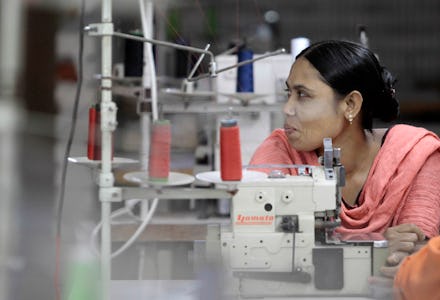Why It's Time for a Fashion Revolution

Fifteen years ago, kale wasn't a thing. Then we had an organic food revolution. Five years ago, it was inconceivable to make the trip from Washington, D.C. to New York City without filling up your car's gas tank. Now, we're in the midst of an electric car revolution. Today, only 2% of all textile manufacturing worldwide is done in the United States, down from 90% in 1960. It's time for a fashion revolution.
Thursday marks the one-year anniversary of the Rana Plaza factory collapse in Bangladesh. In the disaster, 1,113 people were killed and over 2,500 were injured when obvious warning signs about the structural integrity of the building were ignored by local managers who were under pressure from major big-box retailers to meet quotas and satisfy the western need for inexpensive, disposable clothing.
Image Credit: AP. Family members mourning the deceased garment workers.
The Rana Plaza collapse was a wake-up call and a catalyst for change. Since then, a global movement, under the umbrella organization Fashion Revolution Day, has begun. Led by brands, retailers and sustainable fashion pioneers, the movement aims to reveal the story behind our clothing and raise awareness of the need for sustainable fashion. It is a global effort to bring an end to unjust labor practices and protect our environment.
In this modern era of fast fashion and a race to the bottom, the real price for our $10 tees has been paid for by seamstresses working in slave labor conditions, most of whom are women and girls as young as 12 years old. These women and girls make $38 a month so that we can save a few dollars on a T-shirt. That's the horrible reality of most of the clothing we wear.
But Rana Plaza wasn't the first tragic incident of this kind, and it won't be the last. Last year, the Bangladeshi garment industry produced roughly $23 billion in exports to the West, and yet, according to Oxfam International, the 4 million mostly women garment workers are forced to live on half of what Oxfam deems a living wage.
This week as we remember the victims of one of the fashion industry’s worst disasters, it is time to say enough is enough. It is time to come together to raise our voices and demand change. It is time to stand up and say yes, we know where are clothes were made, we know who made them and we know what they were made of. True fashion, good fashion, is a force to be reckoned with. It is an art form, a craft, it is beauty in motion.
Social and environmental catastrophes in our fashion supply chains are still happening all around the world, but there are a lot of incredible brands that are making a difference, brands that are using fashion as a force for good. People Tree works with artisans in developing countries around the world using fair trade practices and organic cotton and reinvests much of the profits into helping the women earn more than a living wage to support their families and their communities. Amour Vert makes all of its clothing in San Francisco and is helping to revitalize America's west coast manufacturing industry. Indigenous has empowered thousands of artisans in Peru and helped elevate them from poverty in some of the poorest regions in South America.
These are the new faces and leaders in fashion. These are brands that know the story of how their clothes are made and are proud of those stories. These are brands that believe in a transparent and fair supply chain.
Fifteen years ago, organic food was for hippies. Now, organic gluten-free black bean chips are in every corner store in New York City. Five years ago, Hummers and other gas-guzzlers dominated our roads, but now Teslas can plug-in on gas stations all along I-95.
Last April, more than 1,000 garment workers needlessly lost their lives so we could have $10 T-shirts. Now it's time to demand better and be proud of who made our clothing. As consumers, we must support brands that practice fair trade or are made here in America. Brands committed to transparent supply chains. Brands that use organic materials. There are several retailers and many great resources that are making it easier to shop sustainable style. It's up to us to vote with our wallet and wear what matters.